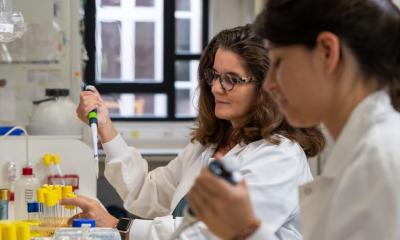Chequerboard of infertility treatment in Europe
European Health Forum Gastein
European patients are in many countries, in fact, limited in their individual choice of medically assisted reproduction (MAR) treatment, experts from the European Society of Human Reproduction and Embryology (ESHRE) stressed today at the European Health Forum Gastein (EHFG).
The EHFG is the most important conference on health care policy in the EU. This year it has attracted about 600 decision-makers from more than 40 countries in the fields of health care policy, research, science and business as well as from patients’ organizations.
Cambridge reproductive biologist Robert Edwards, who has just been awarded the Nobel Prize for Medicine, was a founder member of ESHRE and became the Society's first chairman in 1985. During an ESHRE workshop in Bad Hofgastein the political, professional, industrial and patient perspectives highlighted the problems related to the patchwork of MAR regulation in Europe. The regulatory diversity in MAR is attributed to the religious, cultural, social, ethical and moral attitudes prevalent in individual countries towards human life and its origins. In particular, gamete and embryo donation, surrogacy and preimplantation genetic diagnosis are hot spots in MAR regulation in Europe.
Demand for infertility treatment on the rise
The field of MAR is subject to the EU directive 2004/23/EC on quality and safety of human tissues and cells. “19 Member States have specific legislations in place for MAR, in the remaining eight countries, MAR is covered by the general health legislation”, said Isabel de la Mata from the European Commission. “The organization of health systems is the exclusive competence of the members, meaning the legally allowed forms of treatment, the eligibility criteria and the reimbursement of treatments all vary between the Member States.”
And yet demand for MAR treatment is on the rise in Europe. The latest survey by ESHRE - the only one of its kind in Europe – found that 494,599 treatment cycles were performed in Europe in 2006 compared to 203,893 cycles ten years earlier. The number of clinics reporting to the survey increased from 482 to 1,016 during the same period. In several European countries 2-5% of children are born after MAR, with every one in six couples seeking some sort of medical assistance in order to achieve a pregnancy.
30,000 couples seek treatment outside their home countries
“Due to the inequality of reimbursement and treatment unavailability, many patients seek treatment outside their home country, often putting themselves and their unborn babies at risk,” explained Clare Lewis Jones, Chair of Fertility Europe, the umbrella organization of patient associations in Europe. Cross border travel for reproductive care is becoming a relevant phenomenon in Europe. A recent study by ESHRE showed that an estimated 11,000 to 14,000 patients go abroad for treatment each year in the six European countries studied (Belgium, Czech Republic, Denmark, Switzerland, Spain and Slovenia). “We estimate that about 30,000 couples cross borders each year in Europe to receive assisted reproduction treatment,” said Luca Gianaroli, chairman of ESHRE.
“Less restrictive reimbursement policies leading to increased accessibility and use of MAR would be incentives for the industry to increase development efforts in this area,” said Joan-Carles Arce, Vice President of R&D at Ferring Pharmaceuticals. “In addition, funding of academia-industry collaborations would stimulate further research within MAR and facilitate that new treatment concepts are being developed and subsequently put into clinical practice. It would also have a beneficial impact on the drug development activities if pricing and reimbursement authorities rewarded innovation.”
“ESHRE is concerned about the heterogeneity that still exists in Europe,” explained Luca Gianaroli. “At the European level a serious and fundamental reflection of MAR legislation is necessary to ensure that treatments of proven benefit to patients and offspring are made available in Europe, irrespective of the patient’s income, marital status and place of residence.” ESHRE believes this discussion should take place together with professionals in the fields and patients.
07.10.2010










